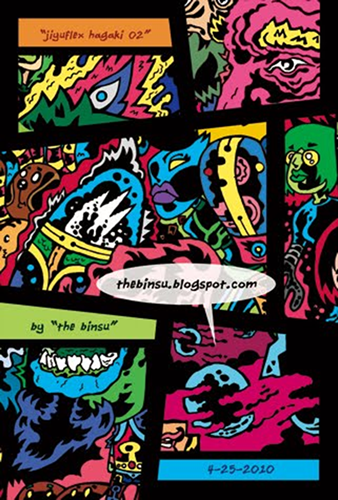翻訳HOME > ギャラリーコールマン |

| ギャラリーコールマンオンライン作品集に戻る |
| 作品タイトル jiyuflex hagaki 02 |

前回紹介した「 jiyuflex hagaki 」シリーズの 2 番目の作品です。この作品も「 jiyuflex hagaki 01 」と同じく、漫画形式のコラージュです。既に完成されていた複数の作品をパソコン上でバラバラにして、コラージュ方法により一つの作品にまとめていた時、色の鮮やかさやバランス、そして構成のインパクト感などを一番大事にしました。メッセージ性などより色や形などの形式的な要素や視覚的な部分を大事にするとは、装飾美術を代表する特徴だと言えると思いますので、本作品も「 jiyuflex hagaki 01 」と同じく、どちらかと言いますと装飾的な作品だと言っても間違えではありません。但し、コラージュを作るのに使った自作のイラストはすべて装飾芸術的な作品ではありませんでした。今回はその元となるイラストを描く過程について少し語らせて頂きたいと思います。 This second piece from the "jiyuflex hagaki" series that I wrote about last time. Just like "jiyuflex hagaki 01," it is a collage in a comic book format. When I used the collage method to assemble bits of already completed pieces that I had taken apart on the computer, the elements I focused on the most were things like the brightness and balance of color and the impact of the composition. Focusing on formal elements like color and shape or the visual component over the conceptual message could be considered the representative characteristic of decorative art, so on one hand it would not be wrong to classify this as a decorative piece along with "jiyuflex hagaki 01." However, none of the drawings I made and used as material to make the collage were decorative art pieces. I would like to write a bit here about the process of creating these drawings. 私が良く描く空想の生き物や不思議な機械などはどんなジャンルかと聞かれたら、一言で答えができません。どうしても答えなければいけない時、「シュールなイラスト」や「変わったイラスト」は良く言いますが、実際のところ、不条理な世界、事物のありえない組み合わせなどを写実的に表現する「シュールレアリスム」でもありませんし、単純に「変わった」ものでもありません。 When asked what genre would I used to describe the imaginary creatures and strange machines that I tend to draw a lot, I can't really sum it all up into one name. When I have to answer in those terms, I usually just say that I draw "surreal drawings" or "strange drawings," but in actuality, these pieces do not really belong to surrealism with its habit of realistically expressing an absurd world or an impossible juxtaposition of objects, nor are they simply "strange." 文学の世界では思い付いたことをそのまま書いていく「意識の流れ」という書き方がありますが、どちらかと言いますと私はこの「文学的な意識の流れ」という書き方をイラストの世界に持っていって、「視覚的な意識の流れ」と呼んでも良いプロセスで描いています。一般的に、美術の制作過程では絵を描き始める前に構成、色のバランス、モチーフの形などはスケッチを通して決めるのは普通ですが、私の場合はこのような要素を考えずにペンを手にとることが多いです。鉛筆でまずモチーフの形をある程度決めてからペンで仕上げるという方法はたまに使いますが、鉛筆を使わずにペンで直接描き始めることがほとんどです。そのように制作していますと、描いているうちにモチーフの形が魔法のように現れてきます。そのモチーフがまるで自分の意志で生まれてくるかのようです。どちらかと言いますと、空を見上げると動物や文字などの形が雲に見えてくるプロセスと似ているかもしれません。ただし、モチーフが「見えてくる」というより、「自ら現れてくる」という感じがします。「あっ、ひげを描いた」、あっ、「顔になった」 … そのような感覚ですね。 In the realm of literature, there is a method of writing called "stream of consciousness" writing wherein the author writes things as they come to mind. What I do is sort of like taking the concept of stream of consciousness writing from the world of literature into the world of drawing, and in that sense it could possibly be called a "visual stream of consciousness" process. In the process of creating art, elements like color balance and the shape of the subject are usually determined through sketching before actually drawing the piece. But I generally tend to take pen in hand without thinking about these elements. Sometimes I will determine the shape of the subject to some extent with a pencil before finishing the work in pen, but most of the time I start drawing directly with the pen and don't use a pencil at all. When I draw in this way, the shape of the subject takes form on the paper while I am drawing like magic. It's almost like it comes into being with a will of its own. Maybe you could say that it is kind of similar to the process of seeing shapes like animals or letters in clouds when you look up at the sky. But instead of seeing the subject in something, it is more like it appears on its own out of nowhere. It's kind of like, "wow, I just drew a beard," and, "oh, that shape became a face..." 描き始める前に「何を描きますか」と聞かれても答えられないことも多く、かえってモチーフを決めてから描きますと描きにくくなり、楽しくなくなることもあります。そしてその場合完成度が低くなることも多いです。 If someone were to ask me, "What are you going to draw?" before I start drawing, a lot of the time I wouldn't be able to answer. And actually, if I decide on what I want to draw first and then start drawing, drawing can become difficult and not fun anymore sometimes. In that case, the drawing usually doesn't look good at all. ですので、もしかして「シュールレアリスム」や「変わったイラスト」より、「意識の流れができたイラスト」と言った方が良いかもしれません。文学でも視覚的な美術の作品の制作でも意識の流れという過程でアイデアを引き出すとは、「潜在意識」と呼ばれている私たちの心の奥深くに眠っている潜在力を利用することにつながると思います。よって、出てくるアイデアや視覚的な形はそんな潜在意識の意志を伝えるシンボルでもあると思います。 So, maybe instead of calling my art "surrealism" or "strange drawings," it would be better to call it "drawings created through a stream of consciousness." I think that coming up with ideas through the stream of consciousness process, whether it be in terms of literature or making visual art, is connected to drawing upon that latent power sleeping deep within our minds that we call "the subconscious." And in that way, I think that the ideas and visual shapes that come forth in this way are also symbols that communicate the will of this subconscious. 自分の潜在意識から発生された要素が含まれているイラストは必ず非常に個人的なものになり、他の人に何も意味を持たないイラストになる恐れに常に向き合わなければいけませんが、自分の「潜在意識」の意図(こう描きなさいという命令のようなもの)を忠実に感じ取ったまま、「顕在意識」で調整する行為を最低限に抑えながら表現して、描いている瞬間の自分のすべてを込めて制作しましたら、見る方の心の奥(または潜在意識)にそのメッセージが伝わると信じていきたいと思います。 Drawings that contain elements generated from your own subconscious are necessarily incredibly personal things, and you always have to face the possibility that these kinds of drawings will have absolutely no meaning to anyone else. But I would like to believe that if you express the intent of your own subconscious mind (which is kind of like a command saying, "Draw this.") faithfully to the way you feel it, keeping any editing with your "conscious mind" to a minimum, and funnel into your work the entirety of the "you" that exists at that moment when you are drawing, that message will communicate itself deep into the heart (or the subconscious) of the viewer. ちなみに、今回のコラムの日本語の方に「モチーフ」という言葉を使いましたが、英語の方では「 motif 」ではなく、「 subject 」にしました。アメリカの大学で美術を学んでいたころ、先生方や他の学生たちが皆「 motif 」より「 subject 」という言葉を使っていました。今度日本の大学で美術を勉強することになったら、「モチーフ」という言葉が圧倒的に使われていて、慣れるのに多少時間がかかりました。 Incidentally, I used the word "motif" in the Japanese portion of this column, but I used the word "subject" instead in the English portion. When I was studying art at an American university, the teachers and other students used the word "subject" instead of "motif." But when I studied art at a Japanese university after that, the word "motif" was used to an incredible extent, and it took me a while to get used to that. |